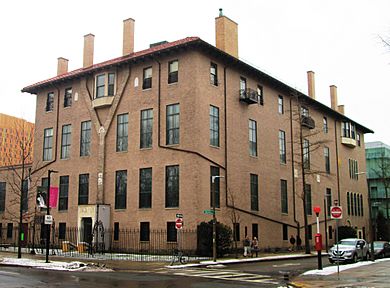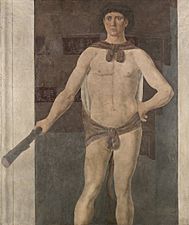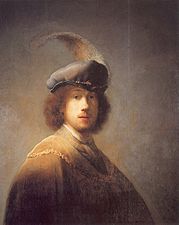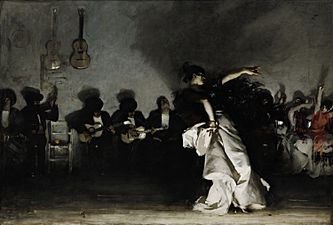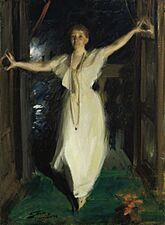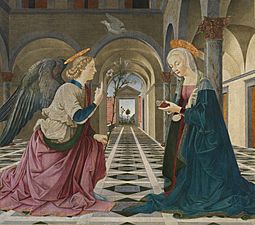Isabella Stewart Gardner Museum facts for kids
 |
|
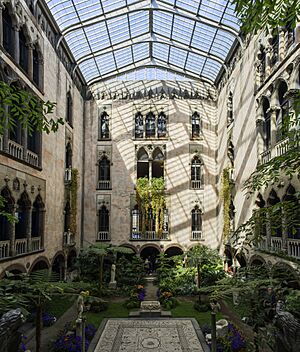
Courtyard
|
|
| Lua error in Module:Location_map at line 420: attempt to index field 'wikibase' (a nil value). | |
| Former name | Fenway Court |
|---|---|
| Established | 1903 |
| Location | 25 Evans Way Boston, MA 02115 |
| Type | Art museum |
| Accreditation | American Alliance of Museums |
| Founder | Isabella Stewart Gardner |
| Public transit access | |
The Isabella Stewart Gardner Museum is a special art museum in Boston, Massachusetts. It holds amazing art from Europe, Asia, and America. You can see paintings, sculptures, tapestries, and decorative items there.
The museum was created by Isabella Stewart Gardner. She wanted her art collection to be shown forever. Her goal was for everyone to learn from and enjoy the art. The museum first opened its doors in 1903.
In 2012, a new part of the museum was finished. It was designed by a famous Italian architect named Renzo Piano. This new building is right next to the original one.
Sadly, in 1990, some of the museum's artworks were stolen. The mystery of who took them is still unsolved. The missing art has never been found.
Contents
History of the Museum
The museum was built between 1898 and 1901. Isabella Stewart Gardner (1840–1924) was an American art collector and supporter of the arts. She designed the museum to look like a beautiful 15th-century palace from Venice, Italy. It opened to the public in 1903.
Isabella started collecting art seriously in 1891. She bought a painting called The Concert by Johannes Vermeer in 1892. This was one of her first big art purchases. Later, with help from an expert named Bernard Berenson, she bought a painting by Sandro Botticelli. She was the first American to own a painting by this famous Renaissance artist. Berenson helped her find almost 70 artworks for her collection.
After her husband died in 1898, Isabella decided to build a special place for their art. She bought land in Boston and hired architect Willard T. Sears. She called her new museum "Fenway Court." Isabella was very involved in the design. She spent a year arranging her collection. She mixed paintings, furniture, and objects from different cultures and times. This created a unique and personal experience for visitors.
The museum opened on January 1, 1903, with a big party. The Boston Symphony Orchestra played music. In 1909, the Museum of Fine Arts moved nearby.
Isabella welcomed artists, musicians, and scholars to her museum. They came to find inspiration from the art and the beautiful Venetian setting. Even today, the museum continues her legacy. It has an artist-in-residence program, garden displays, concerts, and educational programs.
When Isabella Gardner passed away in 1924, she left money to support the museum. She also made rules for how her collection should be shown. She wanted it to be "for the education and enjoyment of the public forever."
The Art Theft of 1990
On March 18, 1990, a major art theft happened at the museum. Two people dressed as police officers stole thirteen artworks. These pieces included The Concert by Johannes Vermeer. This is one of only 34 known paintings by Vermeer. Another missing painting is The Storm on the Sea of Galilee (1633) by Rembrandt. It is Rembrandt's only known painting of a seascape. Some of the paintings were cut right out of their frames.
The stolen artworks have never been found. The museum offered a large reward for information to get the art back. Empty frames still hang in the Dutch Room. They are there to show where the missing works once were. Experts were puzzled by which artworks were stolen. Some even more valuable pieces were left behind.
In April 2021, a four-part TV show about the theft was released. It was called This Is a Robbery: The World’s Biggest Art Heist.
New Building and Preservation
In 2002, the museum decided it needed a new building. This was to help protect the historic original building. It also created more space for programs that continue Isabella Gardner's ideas. In 2004, Renzo Piano, a famous architect, was chosen to design the new wing.
The new building was approved in 2009. It was praised for its look in 2016. The design was made to fit well with the historic museum. It uses similar sizes, shapes, and materials.
The project added about 70,000 square feet of space. It includes two new buildings. One building connects to the original museum. It looks like four stories made of glass and copper. The second, smaller building is used for greenhouses and living areas. The new spaces are for visitors, concerts, special exhibits, and educational programs. This helps the museum continue Isabella Gardner's love for art, music, and gardening. The new wing was finished in 2012 and cost $118 million.
Museum Design
The museum building was designed to look like a 15th-century Venetian palace. It creates a special feeling for Gardner's unique collection. Isabella hired Willard T. Sears to design the building. Inside, three floors of galleries surround a beautiful garden courtyard. This courtyard is decorated with Roman mosaics. It is full of blooming plants all year round. The fourth floor used to be Gardner's private home. Now it is used for offices and sometimes for exhibits.
Many people think the building was brought from Venice. But it was actually built from scratch in Boston. It used new materials. However, it does include many old architectural pieces from Europe. These pieces came from Gothic and Renaissance buildings. They were added into the design of the new museum. Special tiles were made for the floors. Modern concrete was used for some parts. Old column tops sit on new columns. The indoor garden courtyard has a glass roof. Its steel supports are original to the building.
The Gardner Museum is loved for its cozy feeling. The artworks are displayed in a personal way. The courtyard is always filled with flowers. Most art pieces do not have labels. The lighting is often dim, like in a private home, not a modern museum.
In 1983, the museum was added to the National Register of Historic Places. In 2013, it was named a Boston Landmark.
Art Collection
Isabella Gardner collected and carefully arranged over 7,500 items. These include paintings, sculptures, furniture, and textiles. There are also silver, ceramics, 1,500 rare books, and 7,000 historical documents. The collection spans ancient Rome, Medieval Europe, Renaissance Italy, Asia, the Islamic world, and 19th-century France and America.
Famous artists in the museum include Titian, Rembrandt, Michelangelo, Raphael, Botticelli, Manet, Degas, Whistler, and Sargent. The first painting by Henri Matisse ever bought by an American is in the Yellow Room.
Well-known artworks include Titian's painting of Europa, John Singer Sargent's El Jaleo, and his Portrait of Isabella Stewart Gardner. You can also see Fra Angelico's Death and Assumption of the Virgin, Rembrandt's Self-Portrait, Aged 23, and Botticelli's painting of Lucretia.
The museum's archives hold over 7,000 letters. These are from 1,000 different people, including famous writers and thinkers. There are also travel albums and old receipts.
The galleries also have Gardner's large book collection. It includes early editions and handwritten copies of works by Dante. There are also very old printed books and beautifully decorated manuscripts.
What's Happening Now
The museum often has special exhibits, talks, and family activities. These events help people learn more about the historic collection. The Artist-in-Residence program invites artists to live at the museum. They get to find inspiration from the art and surroundings. The museum often shows contemporary art and hosts performances by these artists.
The Gardner's concert series brings musicians to perform classical music, new music, and jazz. These concerts happen on Sunday afternoons and some Thursday evenings. You can also find concert videos, audio recordings, and a free classical music podcast online.
The Gardner Museum is part of the Monuments Men and Women Museum Network. This network started in 2021.
The museum's central courtyard always has changing seasonal flower displays. These show Isabella's favorite plants and gardening interests. Most of the plants are grown off-site in the museum's nursery. Then they are brought to the museum for each new display. Some recent displays included Hanging Nasturtiums, Hydrangeas, and Midwinter Tropics.
The museum offers free admission for life to anyone named Isabella!
Recent Exhibitions
The Gardner Museum has hosted many interesting exhibitions. Here are a few examples:
- Cosme Tura: Painting and Design in Renaissance Ferrara (2002)
- Making of the Museum: Isabella Stewart Gardner as Collector, Architect, and Designer (2003)
- Raphael, Cellini and a Renaissance Banker: The Patronage of Bindo Altoviti (2003–2004)
- Gentile Bellini and the East (2005–2006)
- Donatello, Michelangelo, Cellini: Sculptors' Drawings from Renaissance Italy (2014–2015)
- Fra Angelico: Heaven on Earth (2018)
- Botticelli: Heroines + Heroes (2019)
- Boston's Apollo: Thomas McKeller and John Singer Sargent (2020)
- Titian: Women, Myth & Power (2021–2022)
- Betye Saar: Heart of a Wanderer (2023)
- Raqib Shaw: Ballads of East and West (2024)
- On Christopher Street: Transgender Portraits by Mark Seliger (2024)
- Waters of the Abyss: An Intersection of Spirit and Freedom (2025)
Contemporary Art Exhibitions
The Gardner also features modern art. Here are some past contemporary art exhibitions:
- Danijel Zezelj: Stray Dogs (2005)
- Henrik Håkansson: Cyanopsitta spixii Case Study #001 (2006)
- Stefano Arienti: The Asian Shore (2007)
- Su-Mei Tse: Floating Memories (2009)
- Taro Shinoda: Lunar Reflections (2009–2010)
- Points of View: 20 Years of Artists-in-Residence at the Gardner (2012)
- Sophie Calle: Last Seen (2013–2014)
- Carla Fernández: The Barefoot Designer: A Passion for Radical Design and Community (2014)
Gallery
-
Hercules by Piero della Francesca (after 1465)
-
Study for the Colonna Pietà (c. 1538) by Michelangelo
-
Lady in Black (1598–99) by Tintoretto
-
Self-portrait, aged 23 (1629) by Rembrandt
-
El Jaleo (1882) by John Singer Sargent
-
Isabella Stewart Gardner in Venice (1894) by Anders Zorn
See also
 In Spanish: Museo Isabella Stewart Gardner para niños
In Spanish: Museo Isabella Stewart Gardner para niños


